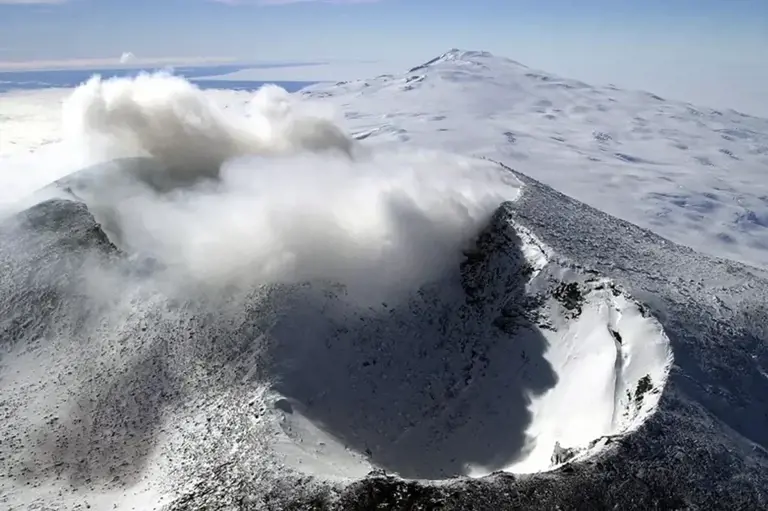Antarctic Glacier Formations reveal fascinating new details about ice melting processes. Discover how scientists uncovered mysterious shapes beneath the Dotson Glacier and what this means for our understanding of ice shelf dynamics.

© Live Science, Filip Stedt, Uniwersytet w Göteborgu
Antarctic Glacier Formations: Uncovering Hidden Mysteries Beneath the Ice
Antarctic Glacier Formations have long intrigued scientists and researchers, but a recent study has shed light on some truly remarkable discoveries. Understanding how ice melts from beneath is crucial for grasping the ice cycle in Antarctica and its impact on global sea levels. To explore these processes, scientists used a remotely operated vehicle to delve into the depths of the Dotson Glacier, leading to unexpected and astonishing findings.
A Deep Dive into the Glacier
The Dotson Glacier, located in western Antarctica, is a massive ice formation about 50 kilometers wide. It sits on the coast of Marie Byrd Land and is known for its potential to significantly impact sea levels. Previous studies had indicated that warm ocean water was eroding the glacier from underneath, but the full extent of this process remained unclear.
In 2022, scientists embarked on a mission to investigate the glacier’s underside more closely. They deployed a remotely operated vehicle (ROV) capable of traveling around 1,000 kilometers beneath the glacier, reaching a depth of about 18 kilometers. This mission aimed to capture the most accurate images of the glacier’s base and to understand better how it melts from beneath.
Revealing the Ice’s Secrets
Antarctic Glacier Formations at the base of the Dotson Glacier were far from what scientists had anticipated. Instead of a smooth, uniform surface, the team found numerous unusual shapes. These formations, some stretching up to 400 meters, were not symmetrical and had a teardrop-like appearance.
Using sonar technology, the researchers obtained detailed images of these formations. The findings revealed that the glacier’s melting process was more complex than previously thought. The ice melts most rapidly in areas where underwater currents erode the base. Additionally, cracks in the glacier allow melting ice to move towards the surface.
Understanding the Melting Process
The discovery of these strange shapes provides valuable insights into the glacier melting process. Antarctic Glacier Formations can help scientists understand how underwater currents and the Earth’s rotation influence ice melting. As water moves under the glacier, it creates an uneven melting pattern, leading to the formation of these teardrop-like shapes.
Dr. Anna Wåhlin, the study’s lead author and an oceanography professor at the University of Gothenburg in Sweden, explained that the asymmetry of the shapes is related to the Coriolis force. This force, caused by the Earth’s rotation, affects the direction of water movement in the Southern Hemisphere. It creates a spiral pattern known as the Ekman spiral, which, while usually visible on the water’s surface, also influences how water moves under the glacier.
The Impact on Sea Levels
The Dotson Glacier’s potential to impact global sea levels is significant. If this ice sheet collapses, it could contribute to a sea level rise of approximately 3.4 meters. The recent findings on Antarctic Glacier Formations highlight the urgent need to monitor and understand these processes. As warm ocean waters continue to erode the glacier from below, the potential for ice shelf collapse increases.
Future Research Plans
The team plans to continue their research in January 2024 to build on their recent discoveries. However, their previous ROV was lost during the expedition, making it necessary to deploy a new vehicle to continue exploring the glacier’s underside. Despite this setback, the insights gained from the initial study have already provided a deeper understanding of glacier dynamics and melting processes.
Conclusion
Antarctic Glacier Formations offer a glimpse into the hidden world beneath the ice. The discovery of unusual shapes and patterns at the bottom of the Dotson Glacier enhances our understanding of how glaciers melt and how these processes impact global sea levels. As scientists continue their research, these findings underscore the importance of monitoring and studying the changing dynamics of Antarctica’s ice sheets. By uncovering the secrets beneath the ice, we can better prepare for and mitigate the effects of climate change on our planet’s future.
ALSO READ:
Nuclear Weapons Testing: 5 Devastating Reasons Experts Are Alarmed


